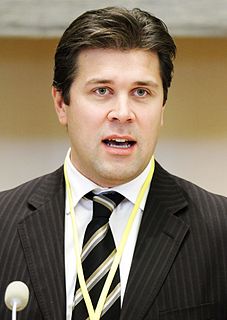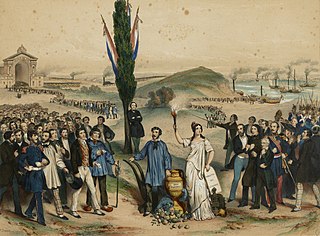
Party-list proportional representation systems are a family of voting systems emphasizing proportional representation (PR) in elections in which multiple candidates are elected through allocations to an electoral list. They can also be used as part of mixed additional member systems.
Elections to determine the makeup of the legislative bodies on the three levels of administrative division in the Kingdom of Sweden are held once every four years. At the highest level, these elections determine the allocation of seats in the Riksdag, the national legislative body of Sweden. Elections to the 20 county councils (landsting) and 290 municipal assemblies (kommunfullmäktige) – all using roughly the same electoral system – are held concurrently with the legislative elections on the second Sunday in September.
Mixed-member proportional (MMP) representation is a mixed electoral system in which voters get two votes: one to decide the representative for their single-seat constituency, and one for a political party. Seats in the legislature are filled firstly by the successful constituency candidates, and secondly, by party candidates based on the percentage of nationwide or region-wide votes that each party received. The constituency representatives are elected using first-past-the-post voting (FPTP) or another plurality/majoritarian system. The nationwide or region-wide party representatives are, in most jurisdictions, drawn from published party lists, similar to party-list proportional representation. To gain a nationwide representative, parties may be required to achieve a minimum number of constituency candidates, a minimum percentage of the nationwide party vote, or both.
The highest averages method or divisor method is the name for a variety of ways to allocate seats proportionally for representative assemblies with party list voting systems. It requires the number of votes for each party to be divided successively by a series of divisors. This produces a table of quotients, or averages, with a row for each divisor and a column for each party. The nth seat is allocated to the party whose column contains the nth largest entry in this table, up to the total number of seats available.
Open list describes any variant of party-list proportional representation where voters have at least some influence on the order in which a party's candidates are elected. This as opposed to closed list, which allows only active members, party officials, or consultants to determine the order of its candidates and gives the general voter no influence at all on the position of the candidates placed on the party list. Additionally, an open list system allows voters to select individuals rather than parties. Different systems give voter different amounts of influence. Voter's choice is usually called preference vote.
Elections in Greece gives information on elections and election results in Greece.

Parliamentary elections were held in Iceland on 12 May 2007. The Independence Party remained the largest party in the Althing, winning 25 of the 63 seats.

A parliamentary election was held in Iceland on 25 April 2009 following strong pressure from the public as a result of the Icelandic financial crisis. The Social Democratic Alliance and the Left-Green Movement, which formed the outgoing coalition government under Prime Minister Jóhanna Sigurðardóttir, both made gains and formed an overall majority of seats in the Althing. The Progressive Party also made gains, and the new Citizens' Movement, formed after the January 2009 protests, gained four seats. The big loser was the Independence Party, which had been in power for 18 years until January 2009: it lost a third of its support and nine seats in the Althing.

An electoral system is a set of rules that determine how elections and referendums are conducted and how their results are determined. Political electoral systems are organized by governments, while non-political elections may take place in business, non-profit organisations and informal organisations.

Parliamentary elections were held in Iceland on 24 June 1934. They were the first held after reforms to the electoral system that increased the number of seats in the Lower House from 28 to 33 and ensured that all members of the Althing were elected at the same election. The Independence Party emerged as the largest party in the Lower House, winning 14 of the 33 seats.

An Icelandicparliamentary election was held on 27 April 2013. Fifteen parties contested the election in Iceland, compared to just seven in the previous election. The election was won by the two centre-right opposition parties, the Independence Party and Progressive Party, who subsequently formed a coalition government. The parties are eurosceptic, and their win brought to a halt partially completed negotiations with the European Union regarding Icelandic membership.
Dual-member proportional representation (DMP), also known as dual-member mixed proportional, is an electoral system designed to produce proportional election results across a region by electing two representatives in each of the region’s districts. The 1st seat in every district is awarded to the candidate who receives the most votes, similar to first-past-the-post voting (FPTP). The 2nd seat is awarded to one of the remaining district candidates so that proportionality is achieved across the region, using a calculation that aims to award parties their seats in the districts where they had their strongest performances.
Apportionment in the Hellenic Parliament refers to those provisions of the Greek electoral law relating to the distribution of Greece's 300 parliamentary seats to the parliamentary constituencies, as well as to the method of seat allocation in Greek legislative elections for the various political parties. The electoral law was codified for the first time through a 2012 Presidential Decree. Articles 1, 2, and 3 deal with how the parliamentary seats are allocated to the various constituencies, while articles 99 and 100 legislate the method of parliamentary apportionment for political parties in an election. In both cases, Greece uses the largest remainder method.
















